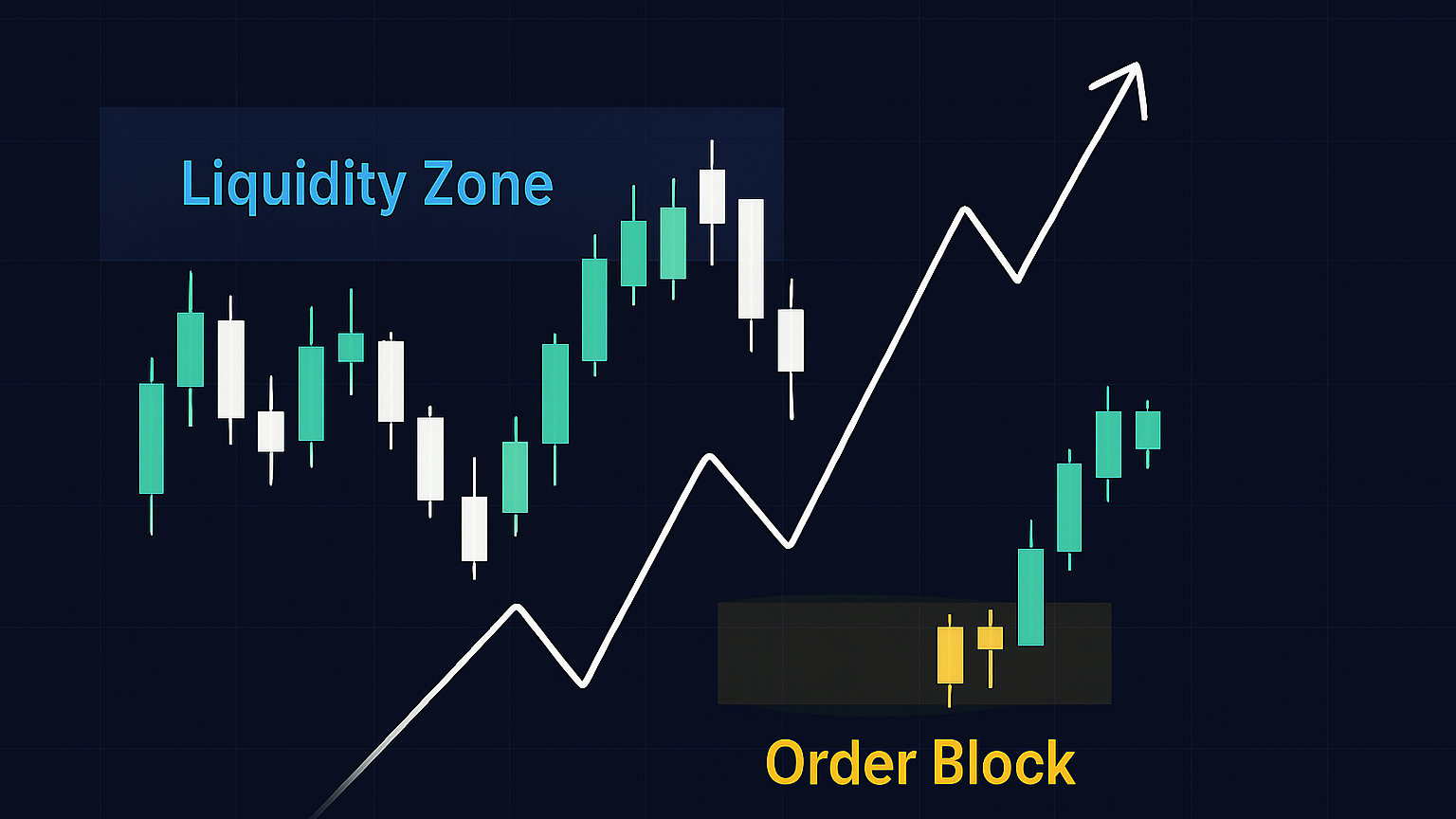Explore the key differences between liquidity zones and order blocks, and learn how to apply them for better trading strategies.
Liquidity zones and order blocks are essential concepts for traders to understand market structure and improve their strategies.
- Liquidity Zones: Broader price areas where orders cluster, often marked by high volume, strong price rejections, and consolidations. Useful for spotting general market trends and areas of interest.
- Order Blocks: Specific price levels tied to institutional trading activity, identified by liquidity sweeps, price imbalances, and untested levels. Ideal for precise entry and exit points.
Quick Comparison
| Feature | Liquidity Zones | Order Blocks |
|---|---|---|
| Formation | From overall market activity | From institutional orders |
| Identification | Volume spikes, rejections, consolidation | Liquidity sweeps, imbalances |
| Precision | Broader areas | Specific price levels |
| Timeframe Impact | Found across all timeframes | Most effective on higher timeframes |
| Price Movement | Indicate reactive areas | Define key support/resistance levels |
Key Takeaway: Use liquidity zones to understand broader trends and order blocks for pinpointing institutional activity. Combining both enhances trading precision and risk management.
Main Differences
How Liquidity Zones Work
Liquidity zones form naturally where a large number of orders gather. They often display these characteristics:
- Huge volume spikes when tested
- Strong price rejections with long wicks
- Extended consolidation periods
- Multiple reactions at the same price level
These zones often lead to liquidity sweeps, allowing institutions to enter positions with minimal slippage. While liquidity zones reflect overall market behavior, order blocks highlight specific institutional actions.
How Order Blocks Work
Order blocks represent deliberate actions by institutional traders, pinpointing price levels where significant orders are concentrated. A valid order block typically has three main features:
- A prior liquidity sweep, signaling institutional accumulation
- A clear price imbalance
- No retest after its formation
LuxAlgo provides a Price Action Concepts (PAC) toolkit on TradingView that simplifies the process of identifying order blocks by automating their detection to help traders spot institutional activity in real time.
Side-by-Side Comparison
| Feature | Liquidity Zones | Order Blocks | Combined Strategy |
|---|---|---|---|
| Entry Timing | Provides broader context | Offers precise entry points | Enter trades when both align |
| Stop Loss | Use zone boundaries | Place tighter stops at block levels | Set stops using order block levels within zones |
| Position Sizing | Larger due to wider stops | Allows for tighter, more aggressive stops | Adjust based on the strength of confirmations |
| Timeframe Focus | Analyze multiple timeframes | Focus on higher timeframes | Start with higher timeframes, confirm using lower ones |
"An order block is a significant price level at which large institutional traders place orders. These blocks help predict market movements and act as crucial support and resistance areas."
– Sarah Abbas
In short, liquidity zones are great for understanding broader market trends, while order blocks are better for pinpointing specific price levels tied to institutional activity. Both play unique roles in trading strategies.
Trading Applications
Trading with Liquidity Zones
Liquidity zones are key areas where trading volume surges, often marking critical price levels. These zones typically emerge where significant market activity takes place. When working with liquidity zones, keep these points in mind:
- Pinpoint zones showing high volume and strong price rejections.
- Use multiple timeframes to ensure alignment across different views.
- Look for consolidation periods as they often signal potential liquidity zones.
Trading with Order Blocks
Order blocks highlight specific price levels tied to institutional trading activity, offering precise entry and exit points. The Price Action Concepts (PAC) toolkit available on TradingView automatically identifies and validates these order blocks, simplifying the process for traders.
-
Bullish Order Block Setup
In a downtrend, look for bullish candlesticks that counter bearish momentum. Mark the order block range to the right and enter a trade on the breakout, placing stops below the formation. -
Bearish Order Block Setup
In an uptrend, identify bearish engulfing patterns. Mark the target zone from the last upward candlestick and go short when the price exits the range.
Using Both Tools Together
Combining liquidity zones with order blocks enhances entry precision and risk management. Here's a comparison framework to guide your strategy:
| Analysis Level | Liquidity Zones | Order Blocks | Combined Strategy |
|---|---|---|---|
| Entry Timing | Provides broader context | Offers precise entry points | Enter trades when both align |
| Stop Loss | Use zone boundaries | Place tighter stops at block levels | Set stops using order block levels within zones |
| Position Sizing | Larger due to wider stops | Allows for tighter, more aggressive stops | Adjust based on the strength of confirmations |
| Timeframe Focus | Analyze multiple timeframes | Focus on higher timeframes | Start with higher timeframes, confirm using lower ones |
LuxAlgo Price Action Concepts Toolkit
LuxAlgo’s Price Action Concepts (PAC) toolkit is designed to streamline the process of identifying key trading areas on TradingView. The toolkit leverages advanced order block detection to automatically spot areas where institutional orders have concentrated, offering precise entry and exit signals. In addition to order block detection, the PAC toolkit includes liquidity grab detection, which identifies moments when large players sweep liquidity from the market, potentially marking reversal zones. This dual functionality empowers traders to better understand market dynamics, adapt their strategies, and manage risk more effectively. Whether you are a novice or an experienced trader, the PAC toolkit provides actionable insights that can help refine your trading decisions.
Liquidity Concepts SIMPLIFIED
Common Problems and Risks
Understanding these issues can help you better analyze market structures and navigate potential pitfalls.
Liquidity Zone Challenges
High market volatility can disrupt liquidity zone patterns, leading to:
- False Breakouts: When the price temporarily moves through a liquidity zone but doesn't maintain momentum.
- Timeframe Conflicts: Liquidity zone patterns may vary across different timeframes, causing confusion.
- Event-Driven Disruptions: Unexpected economic or geopolitical events can override typical liquidity zone behavior.
Order Block Challenges
Identifying and trading order blocks during volatile markets comes with its own set of difficulties:
| Challenge | Impact | How to Address It |
|---|---|---|
| Pattern Recognition | Hard to distinguish valid order blocks from false breakouts. | Focus on strong price reactions and clear imbalances. |
| Market Volatility | Past order blocks may lose relevance. | Use volume analysis and consider the market context. |
| Timing Issues | Risk of entering too early or too late. | Wait for clear liquidity grabs before making a move. |
| Block Mitigation | Trading in already tested order blocks. | Avoid blocks that have been previously filled. |
Risk Management Tips
-
Position Sizing
Limit your risk to no more than 2% of your account on a single trade. -
Stop Loss Placement
Base your stop-loss levels on technical signals. -
Profit Management
Maximize gains by:- Setting clear profit targets
- Locking in partial profits early
- Using trailing stops
- Adjusting take-profit levels based on current volatility
Conclusion
Here's a quick recap of the key points and some practical tips to enhance your trading approach.
Main Differences Review
| Feature | Order Blocks | Liquidity Zones |
|---|---|---|
| Origin | Created by institutional orders | Formed by areas of concentrated order activity |
| Precision | Focused on specific price levels | Cover broader price areas |
| Purpose | Useful for predicting reversals | Mark levels where orders accumulate |
Trading Guidelines
Keep these principles in mind:
- Validation: Look for order blocks that show clear liquidity sweeps and price imbalances.
- Context: Consider trend direction, major economic events, trading volume, and alignment with key indicators.
- Integration: Combine insights from both order blocks and liquidity zones to identify stronger trade opportunities.
Tools and Resources
To put this into action, using the Price Action Concepts (PAC) toolkit available on TradingView can be incredibly helpful. Pair this with volume indicators, multi-timeframe analysis, and other technical tools to refine your setups.







